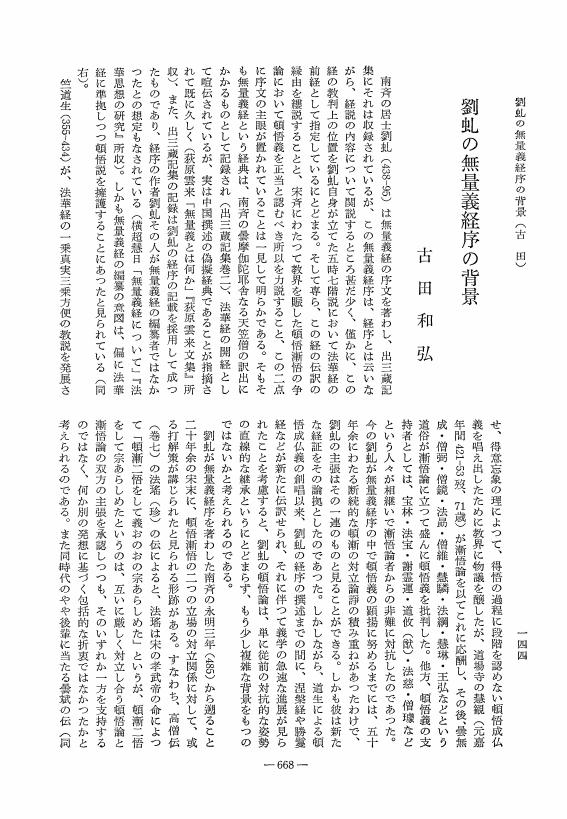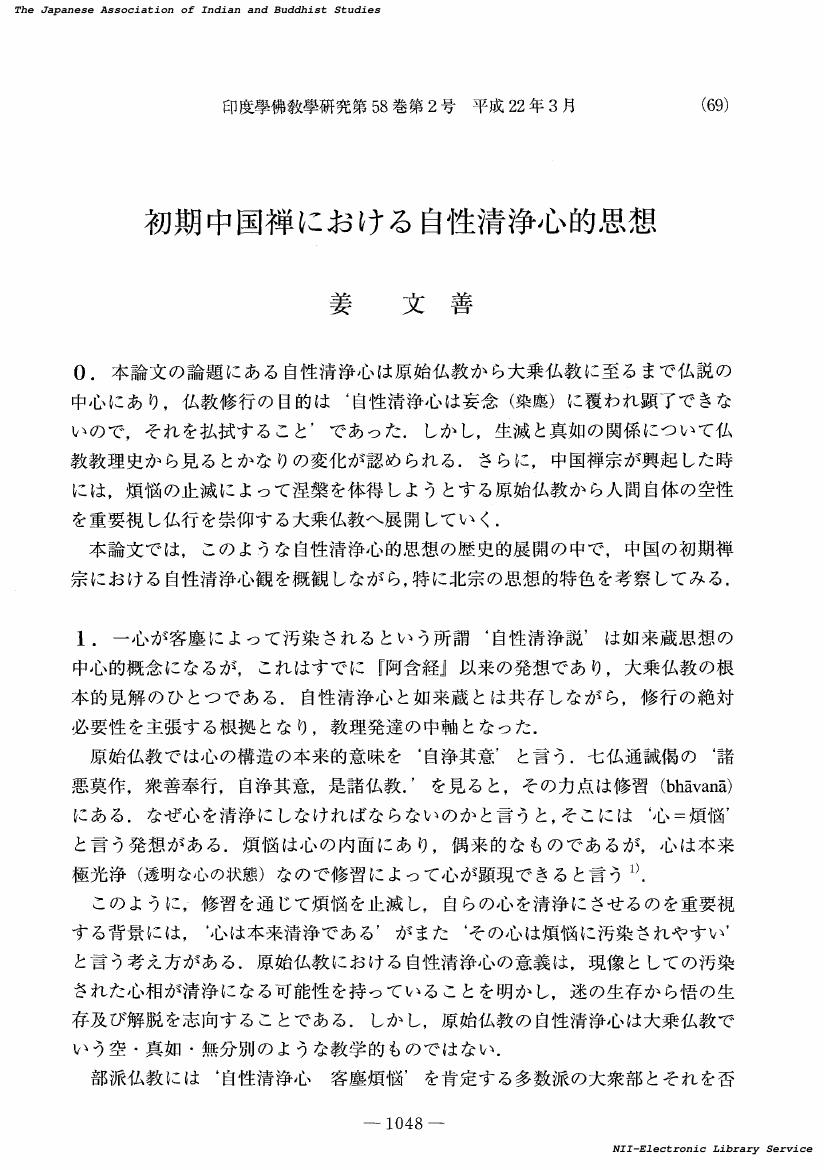1 0 0 0 OA 無にして一の限定へ -維摩經・入不二法門品について-
- 著者
- 兒山 敬一
- 出版者
- Japanese Association of Indian and Buddhist Studies
- 雑誌
- 印度學佛教學研究 (ISSN:00194344)
- 巻号頁・発行日
- vol.7, no.1, pp.57-66, 1958-12-01 (Released:2010-03-09)
1 0 0 0 無量義經について
- 著者
- 横超 慧日
- 出版者
- 日本印度学仏教学会
- 雑誌
- 印度學佛教學研究 (ISSN:00194344)
- 巻号頁・発行日
- vol.2, no.2, pp.453-462, 1954
1 0 0 0 OA 劉〓の無量義経序の背景
- 著者
- 古田 和弘
- 出版者
- Japanese Association of Indian and Buddhist Studies
- 雑誌
- 印度學佛教學研究 (ISSN:00194344)
- 巻号頁・発行日
- vol.25, no.2, pp.668-669, 1977-03-31 (Released:2010-03-09)
1 0 0 0 OA Bhatta Lollata の rasa 論
- 著者
- 上村 勝彦
- 出版者
- Japanese Association of Indian and Buddhist Studies
- 雑誌
- 印度學佛教學研究 (ISSN:00194344)
- 巻号頁・発行日
- vol.34, no.1, pp.424-416, 1985-12-25 (Released:2010-03-09)
1 0 0 0 OA 『立正安国論』と『吾妻鏡』
- 著者
- 関戸 堯海
- 出版者
- Japanese Association of Indian and Buddhist Studies
- 雑誌
- 印度學佛教學研究 (ISSN:00194344)
- 巻号頁・発行日
- vol.45, no.1, pp.232-236, 1996-12-20 (Released:2010-03-09)
1 0 0 0 OA 『五天竺』におけるインド認識
- 著者
- 石崎 貴比古
- 出版者
- 日本印度学仏教学会
- 雑誌
- 印度學佛教學研究 (ISSN:00194344)
- 巻号頁・発行日
- vol.60, no.1, pp.558-555, 2011-12-20 (Released:2017-09-01)
1 0 0 0 OA 中国仏教の道教的展開
- 著者
- 道端 良秀
- 出版者
- Japanese Association of Indian and Buddhist Studies
- 雑誌
- 印度學佛教學研究 (ISSN:00194344)
- 巻号頁・発行日
- vol.19, no.2, pp.544-549, 1971-03-31 (Released:2010-03-09)
1 0 0 0 安然の三昧耶戒説について (二)
- 著者
- 窪田 哲正
- 出版者
- 日本印度学仏教学会
- 雑誌
- 印度學佛教學研究 (ISSN:00194344)
- 巻号頁・発行日
- vol.38, no.1, pp.90-95, 1989
- 著者
- 鈴木 知子
- 出版者
- 日本印度学仏教学会
- 雑誌
- 印度學佛教學研究 (ISSN:00194344)
- 巻号頁・発行日
- vol.68, no.2, pp.1092-1089, 2020
<p>The <i>Rājataraṅgiṇī</i>, a Kashmiri royal chronicle written by Kalhaṇa in the 12<sup>th</sup> century, consists of eight <i>taraṅgas</i> ("waves," i.e. chapters). In the 19<sup>th</sup> century, there was a debate about the authenticity of the last two <i>taraṅgas</i>. The debate seems to have been closed by G. Bühler and A. Stein, who asserted that one and the same Kalhaṇa wrote all eight <i>taraṅgas</i>. Shortly after this discussion was over, it was revealed by an incomplete manuscript that the eighth <i>taraṅga</i> had been revised for political reasons, and the text on which Bühler and Stein had based their assertion was a revised recension. By examination of this newly found manuscript, a question arose about the authenticity of the eighth <i>taraṅga</i>, which was full of rhetorical defects. Apart from textual credibility, it should be noted that the <i>Rājataraṅgiṇī</i> is a <i>kāvya </i>governed by the <i>śānta-rasa</i> (sentiment of equanimity), as declared in the first<i> taraṅga</i>. It is the seventh <i>taraṅga</i> which ends with the tragic death of King Harṣa, that is more suitable for the concluding chapter of a <i>kāvya</i> bearing the <i>śānta-rasa</i>, rather than the eighth <i>taraṅga</i> which ends with a eulogy dedicated to the king of the time. In the 19<sup>th</sup> century, scholars' discussions concerning the <i>Rājataraṅgiṇī</i> were focused on the authenticity of its seventh and eighth <i>taraṅgas</i>. Now, however, the issue should be revisited as a question about the authenticity of the eighth <i>taraṅga</i>.</p>
- 著者
- 吉水 清孝
- 出版者
- 日本印度学仏教学会
- 雑誌
- 印度學佛教學研究 (ISSN:00194344)
- 巻号頁・発行日
- vol.69, no.1, pp.488-481, 2020-12
- 著者
- 下田 正弘
- 出版者
- 日本印度学仏教学会
- 雑誌
- 印度學佛教學研究 (ISSN:00194344)
- 巻号頁・発行日
- vol.68, no.2, pp.1043-1035, 2020
<p>More than fifteen years ago, Schopen (2004, 492) revealed his concern about a certain understanding widespread among scholars of the history of Indian Buddhism, writing, "[t]he historical development of Indian Buddhism used to be presented as simple, straightforward, and suspiciously linear. It started with the historical Buddha whose teaching was organized, transmitted, and more or less developed into what was referred to as <i>early Buddhism</i>. This Early Buddhism was identified as Hīnayāna ... , Theravāda ... , or simply 'monastic Buddhism.' ... A little before or a little after the beginning of the common era this early Buddhism was, according to the model, followed by the Mahāyāna ... " A similar apprehension has recently been expressed in slightly different terms by Harrison (2018, 8–9). It is certainly surprising that scholars' basic frame of reference for the history of Indian Buddhism is more or less what it was in the late 19<sup>th</sup> century, despite all of the progress recently made in this field. Developments in the particulars of the subfields of Indian Buddhist history have not entailed comparable developments in the broader frame of reference, despite the fact that such a frame is what allows us to identify and synthesize the details of our field. This paper attempts to address this problem by focusing on three points: first, it reexamines the current state of affairs of materials for the reconstruction of the history of ancient India; second, it reevaluates the status of Pāli materials as historical sources; and third, it reconsiders the concept of 'canon' in Buddhist studies.</p>
- 著者
- 梁 特治
- 出版者
- 日本印度学仏教学会
- 雑誌
- 印度學佛教學研究 (ISSN:00194344)
- 巻号頁・発行日
- vol.68, no.2, pp.891-887, 2020
<p>It is highly probable that the "Sŏn master Nang" 朗禅師, mentioned at the end of the Tianshun edition of <i>Bodhidharma's Treatise on the Four Practices </i>菩提達摩四行論, is the Silla monk Pŏmnang (c. 630–730), a Dharma successor of the Fourth Patriarch Daoxin 道信 (580–651).</p>
1 0 0 0 OA 大乗仏教における他者の発見
- 著者
- 丘山 新
- 出版者
- Japanese Association of Indian and Buddhist Studies
- 雑誌
- 印度學佛教學研究 (ISSN:00194344)
- 巻号頁・発行日
- vol.50, no.2, pp.885-879, 2002-03-20 (Released:2010-03-09)
1 0 0 0 佛傳における誕生偈の形成過程
- 著者
- 門川 徹眞
- 出版者
- 日本印度学仏教学会
- 雑誌
- 印度學佛教學研究 (ISSN:00194344)
- 巻号頁・発行日
- vol.15, no.2, pp.614-615, 1967
1 0 0 0 OA 解脱に関する考察 -解脱への仏教学的方法を含めて-
- 著者
- 玉城 康四郎
- 出版者
- Japanese Association of Indian and Buddhist Studies
- 雑誌
- 印度學佛教學研究 (ISSN:00194344)
- 巻号頁・発行日
- vol.33, no.1, pp.39-46, 1984-12-25 (Released:2010-03-09)
1 0 0 0 OA 中国北朝仏教における禅について
- 著者
- 白山 和宏
- 出版者
- Japanese Association of Indian and Buddhist Studies
- 雑誌
- 印度學佛教學研究 (ISSN:00194344)
- 巻号頁・発行日
- vol.49, no.1, pp.73-75, 2000-12-20 (Released:2010-03-09)
- 著者
- 田中 ケネス
- 出版者
- 日本印度学仏教学会
- 雑誌
- 印度學佛教學研究 (ISSN:00194344)
- 巻号頁・発行日
- vol.60, no.2, pp.840-839, 2012-03-20 (Released:2017-09-05)
1 0 0 0 OA 龍樹の縁起観・仏陀観
- 著者
- 五島 清隆
- 出版者
- Japanese Association of Indian and Buddhist Studies
- 雑誌
- 印度學佛教學研究 (ISSN:00194344)
- 巻号頁・発行日
- vol.58, no.3, pp.1203-1211, 2010-03-25 (Released:2017-09-01)
龍樹の思想を理解するには,その縁起観の解明が欠かせない.というのも,彼自身はブッダ(釈尊)が説いた縁起を空性と捉えており,一方で,現代の研究者の多くは龍樹の縁起を「相互依存(相依性)の縁起」と捉えているからである.私の研究によれば,『中論頌』における「縁起」の根底にあるのは仏説としての「十二支縁起」であり,邪見・顛倒の断滅による涅槃を目的とした十二支縁起(とくに還滅分)を,戯論の寂滅・分別の滅によって解脱に至る吉祥なる教え(つまり空性の縁起)として捉え直したものである.また,「相互依存の縁起」という捉え方は,まず『空七十論』において強調され,『無畏論』や『青目註』において発展的に継承されていき,一方では『ヴァイダルヤ論』において概念間の関係として展開していき,最終的には,月称によって確立されたものである.つまり,龍樹作とされる文献群やその註釈書においてその縁起観は変化・展開しているのである.その際,注目すべきは,各文献に見られる仏陀観である.龍樹作とされる文献群には「単数形のブッダ」と「複数形のブッダ」の対比が見られるが,『中論頌』では,前者が釈尊を指し,後者は龍樹の思想的支援者(あるいは「大乗のブッダ」)を指している.ところが『六十頌如理論』では逆に,「単数形のブッダ」が「不生不滅」の縁起を説くブッダであり,「複数形のブッダ」は伝統的教理の説者となっている.これが『宝行王正論』になると,「複数形のブッダ」は伝統的な教理も大乗の教理も説く,いわば普遍的な存在と捉えられている.この仏陀観の違いは,各文献の著者が異なることを示している.同様に,龍樹文献群における縁起観の変遷も単に龍樹個人の思想的な発展・深化ではなく,著者そのものの違いを示唆していると考えられる.
1 0 0 0 OA 瑩山禅師と密教の関係について
- 著者
- 竹内 弘道
- 出版者
- Japanese Association of Indian and Buddhist Studies
- 雑誌
- 印度學佛教學研究 (ISSN:00194344)
- 巻号頁・発行日
- vol.49, no.1, pp.211-214, 2000-12-20 (Released:2010-03-09)
1 0 0 0 OA 初期中国禅における自性清浄心的思想
- 著者
- 姜 文善
- 出版者
- 日本印度学仏教学会
- 雑誌
- 印度學佛教學研究 (ISSN:00194344)
- 巻号頁・発行日
- vol.58, no.2, pp.1048-1043, 2010-03-20 (Released:2017-09-01)











